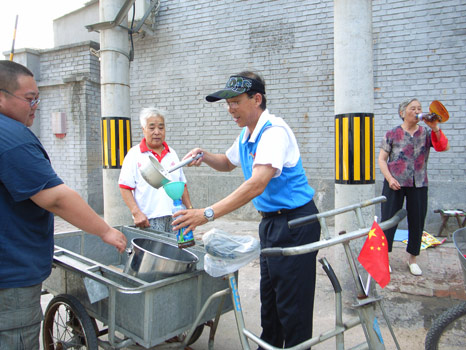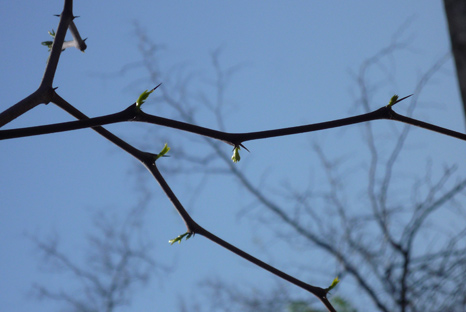
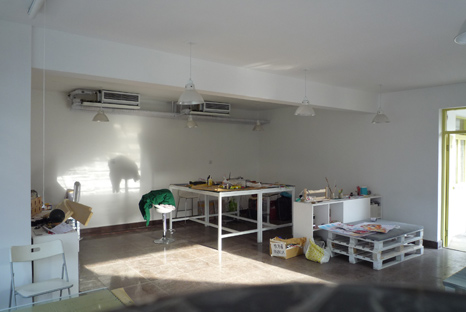
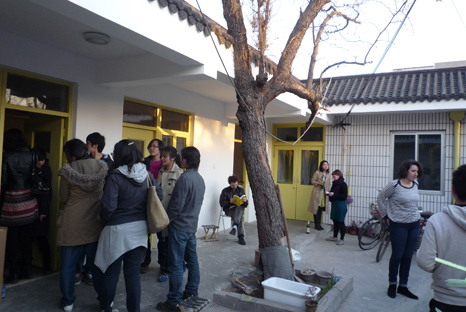
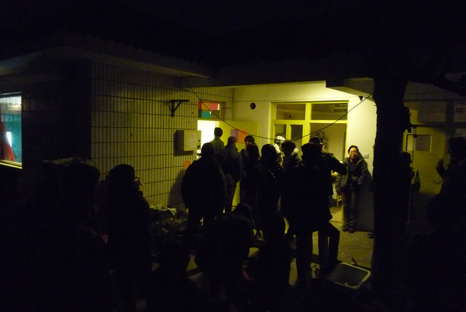
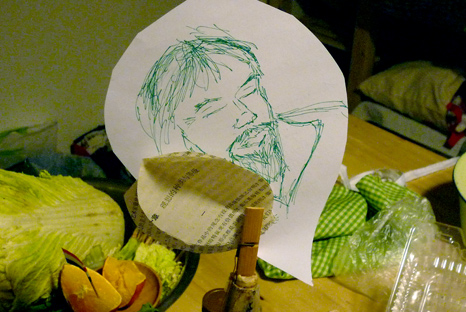
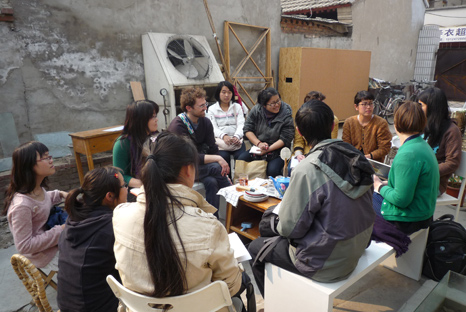
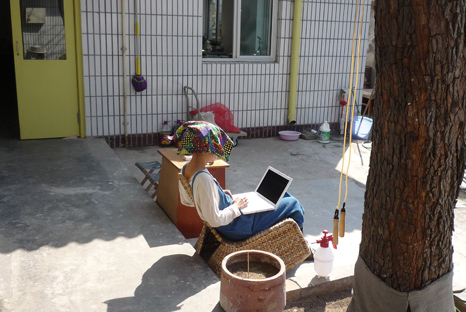

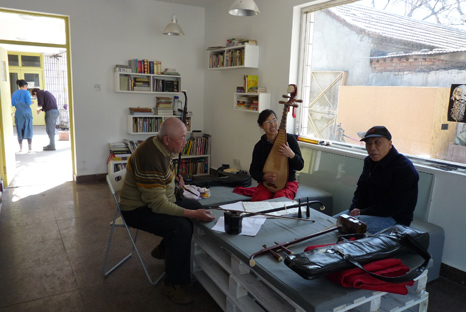


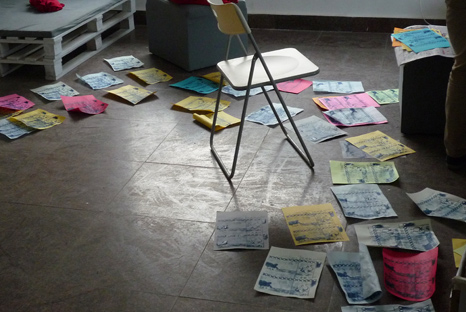
If we had not been able to come closer to an understanding of affect at the reading club meeting, it came to me again in a recent text by another Brian (“The half-life of disaster“), where somehow the descriptive traversing of scales felt familiar, and of course it can hit us with as much impact as watching a slow-motion montage of the year in review, or Olympic triumphs, or yes, the touching moments and heroes of disaster. We should be immune already perhaps, cynical viewers whose forms of belief have decayed parallel to these half-lives, and yet even at standstill, reduced to its barest linguistic denominators, it could still be possible to induce a notion of affective scales on a billboard covering an urban construction site: “Grandpa lazing in the sun. Boys dancing hip-hop. Businessman checking e-mail. Woman carrying shopping bag.” She was kind of pissed off about this, about all that it left out or pinned down too characteristically in succinct world view, but it seemed also something more than ‘trace’ in a collective reading on media. This is an affect of the kind that Michael mentions, “understood as the embodiment of certain codes, to be read and embodied by a particular community”. Such embodiment is a continuous training, like watching these disasters in constant cycle, like urbanity itself. We learn to traverse the levels, moving from horror and shock at grand scale to human warmth and its accompaniments in the everyday heroes and miniature miracles that soothe a constant, half-toned fear.
Taking distance can occur in both directions, towards macro-scale world views or into the safety of the small moments in a day to day. What Massumi claims as a ‘trace-form anticipation’ singularly and collectively describes this back and forth motion; it is a kind of subjective being-in-motion that typifies our here and now condition. To make a hero of our friend A W W abroad stresses the silence nearby, it casts scales of individual activism helplessly against nameless foreboding forces at the state realm, naïvely paralleled by his name being coded “Love the future”. Larger and stronger pursuits of activism in the last years (in education, in the art world, the Middle East, the mid-West…) echo, or are symptomatic of such “affective conversion circuits”, but there remains to be seen what “alter-” could possibly step out of it. Should affect move out of affect? What lies outside of scale itself? The movements seem to encompass everything already, like fantastic ideas kept to oneself, like capitalism’s neverending ever in sight, like half-lives in decay.
—–
* there was a thought at the beginning of writing this post that these photos bore some relation to the things i was going to say, but the distancing ended up there. there is a lot of ambivalent feeling in their transmission, but they speak of a relation…
 时间 posted on: 22 April 2011 |
时间 posted on: 22 April 2011 |  发布者 author: e |
发布者 author: e |  comments (2) |
comments (2) |
 分类 filed under: Brian MASSUMI, 共同体 community, 布莱恩 • 霍姆斯 Brian HOLMES, 日常 everyday, 笔记 notes, 跟踪 tracing
分类 filed under: Brian MASSUMI, 共同体 community, 布莱恩 • 霍姆斯 Brian HOLMES, 日常 everyday, 笔记 notes, 跟踪 tracing
Gentrification and the Everyday
By Edward Sanderson
Part 3: Everyday Life
Occupation, as I talked about in the previous part, is an expression of the Everyday and an important part of Everyday Life involves the active occupation of space, for example in the way the HomeShop has come to occupy its new site. The consequences of occupation threaten institutionalisation, which may lead to gentrification in its imposition of permanent change on an area.
On the other hand institutionalisation protects HomeShop’s work from over-ephemerality or instant dispersal. The positive side of this comes from an example of activism, as Isaac Mao points out:
“… In China, many dissidents and activists are opening up their personal information. Why? Because previously they just wanted to close it down to protect themselves without being tracked by the government. Someone might want people to know his position so he can do things secretly. But now many are opening up this information because they see the social power. Once they’ve opened up their position, home phone, and travel plans, more people in the cloud know where they are at the same time as the authorities. He is protected even as he is tracked.”
(more…)
 时间 posted on: 11 March 2011 |
时间 posted on: 11 March 2011 |  发布者 author: michael eddy |
发布者 author: michael eddy |  comments (5) |
comments (5) |
 分类 filed under: 公共空间 public space, 北京 beijing, 城市 urban, 日常 everyday, 缙绅化 gentrification
分类 filed under: 公共空间 public space, 北京 beijing, 城市 urban, 日常 everyday, 缙绅化 gentrification
Gentrification and the Everyday
By Edward Sanderson
Part 2
In the previous part, I ended by providing a definition of gentrification, as I believe it is generally understood. But, going beyond this and thinking affectively, my original comment on Michael’s post suggests:
“…an insidious insinuation and transformation of a situation, initially through a process of ‘filling a gap’ or perhaps ‘taking advantage of an opportunity.’ At that stage not necessarily a negative activity, but one which opens the door—provides justification—for the ‘real’ ‘gentry’ to usurp those conditions which initiated it…”
In that comment I went on to question whether the Heyri community in Seoul was gentrification per se. This broader definition of gentrification is something I’ve begun to come to terms with in my alternate example of New Malden (brought up in Part 1 of this series).
I also suggested that the nature of the changes typical of the strict definition of gentrification perhaps more applicable to the Beijing situation in which HomeShop finds itself (a subject that Michael began to deal with in his original post), in terms of the socio-economic changes that it represents.
(more…)
 时间 posted on: 4 March 2011 |
时间 posted on: 4 March 2011 |  发布者 author: michael eddy |
发布者 author: michael eddy |  comments (3) |
comments (3) |
 分类 filed under: 日常 everyday, 缙绅化 gentrification
分类 filed under: 日常 everyday, 缙绅化 gentrification
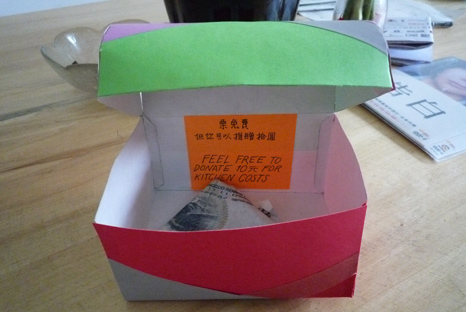
 all photos by 曲一箴 Twist QU*
all photos by 曲一箴 Twist QU*












 时间 posted on: 22 April 2011 |
时间 posted on: 22 April 2011 |  发布者 author:
发布者 author: 
 分类 filed under:
分类 filed under: 